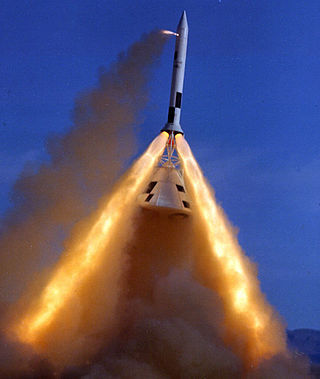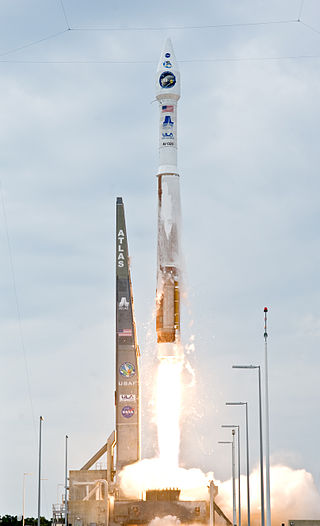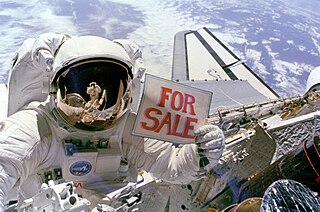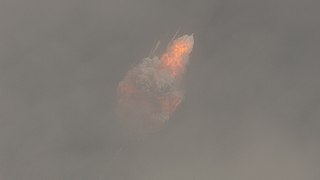Related Research Articles
Human spaceflight programs have been conducted, started, or planned by multiple countries and companies. The age of crewed rocket flight was initiated by Fritz von Opel who piloted the world's first rocket-propelled flight on 30 September 1929. All space flights depend on rocket technology; von Opel was the co-designer and financier of the visionary project. Until the 21st century, human spaceflight programs were sponsored exclusively by governments, through either the military or civilian space agencies. With the launch of the privately funded SpaceShipOne in 2004, a new category of human spaceflight programs – commercial human spaceflight – arrived. By the end of 2022, three countries and one private company (SpaceX) had successfully launched humans to Earth orbit, and two private companies had launched humans on a suborbital trajectory.

A reusable launch vehicle has parts that can be recovered and reflown, while carrying payloads from the surface to outer space. Rocket stages are the most common launch vehicle parts aimed for reuse. Smaller parts such as rocket engines and boosters can also be reused, though reusable spacecraft may be launched on top of an expendable launch vehicle. Reusable launch vehicles do not need to make these parts for each launch, therefore reducing its launch cost significantly. However, these benefits are diminished by the cost of recovery and refurbishment.

Blue Origin Enterprises, L.P. is an American aerospace manufacturer, defense contractor, launch service provider and space technologies company headquartered in Kent, Washington, United States. The company makes rocket engines for United Launch Alliance (ULA) and manufactures their own rockets, spacecraft, satellites, and heavy-lift launch vehicles. The company is the second provider of lunar lander services for NASA's Artemis program and was awarded a $3.4 billion contract. The company has four rocket engines in production including the BE-3U, BE-3PM, BE-4 and the BE-7.

A launch escape system (LES) or launch abort system (LAS) is a crew-safety system connected to a space capsule. It is used in the event of a critical emergency to quickly separate the capsule from its launch vehicle in case of an emergency requiring the abort of the launch, such as an impending explosion. The LES is typically controlled by a combination of automatic rocket failure detection, and a manual activation for the crew commander's use. The LES may be used while the launch vehicle is still on the launch pad, or during its ascent. Such systems are usually of three types:

A launch vehicle is typically a rocket-powered vehicle designed to carry a payload from Earth's surface or lower atmosphere to outer space. The most common form is the ballistic missile-shaped multistage rocket, but the term is more general and also encompasses vehicles like the Space Shuttle. Most launch vehicles operate from a launch pad, supported by a launch control center and systems such as vehicle assembly and fueling. Launch vehicles are engineered with advanced aerodynamics and technologies, which contribute to high operating costs.

Atlas V is an expendable launch system and the fifth major version in the Atlas launch vehicle family. It was originally designed by Lockheed Martin, now being operated by United Launch Alliance (ULA), a joint venture between Lockheed Martin and Boeing. It is used for DoD, NASA, and Commercial payloads. It is America's longest-serving active rocket. After 87 launches, in August 2021 ULA announced that Atlas V would be retired, and all 29 remaining launches had been sold. As of 6 October 2023, 17 launches remain.

New Shepard is a fully reusable sub-orbital launch vehicle developed for space tourism by Blue Origin. The vehicle is named after Alan Shepard, who became the first American to travel into space and the fifth person to walk on the Moon. The vehicle is capable of vertical takeoff and landings. Additionally, it is also capable of carrying humans and customer payloads into a sub-orbital trajectory.

Vertical takeoff, vertical landing (VTVL) is a form of takeoff and landing for rockets. Multiple VTVL craft have flown. The most widely known and commercially successful VTVL rocket is SpaceX's Falcon 9 first stage.

SpaceX CRS-14, also known as SpX-14, was a Commercial Resupply Service mission to the International Space Station launched on 2 April 2018. The mission was contracted by NASA and was flown by SpaceX. This mission reused the Falcon 9 first stage booster previously flown on CRS-12 and the Dragon capsule flown on CRS-8.

The following is a timeline of important events in the history of private spaceflight, including important technical as well as legislative and political advances. Though the industry has its origins in the early 1960s, soon after the beginning of the Space Age, private companies did not begin conducting launches into space until the 1980s, and it was not until the 21st century that multiple companies began privately developing and operating launch vehicles and spacecraft in earnest.
New Glenn is a heavy-lift orbital launch vehicle in development by Blue Origin, named after NASA astronaut John Glenn, the first American astronaut to orbit Earth. Design work on the vehicle began in 2012; illustrations of the vehicle, and the high-level specifications, were initially publicly unveiled in September 2016. New Glenn is a two-stage rocket with a diameter of 7 m (23 ft). Its first stage will be powered by seven BE-4 engines that are also being designed and manufactured by Blue Origin.

The billionaire space race is the rivalry among entrepreneurs who have entered the space industry from other industries - particularly computing. This private spaceflight race involves sending privately developed rockets and vehicles to various destinations in space, often in response to government programs or to develop the space tourism sector.

SpaceXCrew Dragon In-Flight Abort Test was a successful test of the SpaceX Dragon 2 abort system, conducted on 19 January 2020. It was the final assessment for the Crew Dragon capsule and Falcon 9 launch system before they would be certified to carry humans into space. Booster B1046.4 and an uncrewed capsule C205 were launched from Launch Complex 39A (LC-39A) on a suborbital trajectory, followed by an in-flight abort of the capsule at max Q and supersonic speed. The test was carried out successfully: the capsule pulled itself away from the booster after launch control commanded main engine shutdown and landed safely.

Blue Origin NS-16 was a sub-orbital spaceflight mission operated by Blue Origin which flew on 20 July 2021. The mission was the sixteenth flight of the company's New Shepard integrated launch vehicle and spacecraft, and its first crewed flight. It carried into space American billionaire and Blue Origin founder Jeff Bezos, his brother Mark, pilot and Mercury 13 member Wally Funk, and Dutch student Oliver Daemen. The flight commenced from Blue Origin's Corn Ranch sub-orbital launch site in West Texas aboard the third flight of New Shepard booster NS4 and the spacecraft RSS First Step, both having previously flown on NS-14 and NS-15 earlier in the year.
RSS First Step is a New Shepard space capsule, built and operated by American spaceflight company Blue Origin. It is the third New Shepard capsule to fly to space, and the first to fly passengers. Its first flight was the NS-14 mission, which reached an altitude of 107 km (66 mi) on 14 January 2021.
Blue Origin NS-23 was an uncrewed sub-orbital spaceflight mission of Blue Origin's New Shepard rocket, which launched on 12 September 2022. The booster failed during max q about a minute after launch, triggering the launch escape system which removed the capsule from the booster. The capsule landed successfully, while the booster was destroyed upon impact with the ground.
Gary Lai is an American aerospace engineer. He was the chief architect for New Shepard, a vehicle developed by aerospace manufacturer Blue Origin for space tourism. On March 31, 2022, he flew on New Shepard's 20th mission to space, NS-20. He is a Co-Founder and the Chief Technology Officer of a company called Interlune.
Blue Origin NS-17 was an uncrewed sub-orbital spaceflight mission of Blue Origin's New Shepard rocket, which launched on 26 August 2021. It was New Shepards 4th flight in 2021. It was also Blue Origin's 17th overall flight to go into space.
References
- 1 2 Replay: New Shepard Mission NS-24 Webcast , retrieved 2023-12-20
- 1 2 3 4 "Blue Origin Successfully Completes 24th Mission to Space". Blue Origin. Retrieved 2023-12-20.
- ↑ "Today's #NS24 mission stats".
- 1 2 Mike Wall (2023-12-19). "Blue Origin launches New Shepard rocket, aces landing in 1st return to flight since 2022 failure (video)". Space.com. Retrieved 2023-12-20.
- ↑ "New Shepard | NS-24". nextspaceflight.com. Retrieved 2023-12-20.
- ↑ Sesnic, Trevor (2023-12-18). "Blue Origin's New Shepard returns to flight". NASASpaceFlight.com. Retrieved 2023-12-20.
- ↑ Roth, Emma (2023-12-19). "Blue Origin successfully launched and recovered its New Shepard booster". The Verge. Retrieved 2023-12-20.